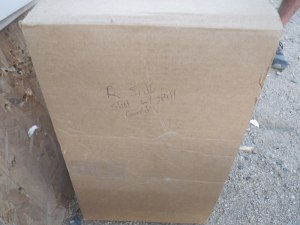As many of my readers know by now, steel plates offer tremendous advantages (low cost, extreme durability/multiple hits, thin profile), but do suffer from issues with front-face spall (fragmentation caused by defeated rounds) and weight. Most solutions that attempt to address this issue exacerbate the weight, and negate the advantage of a thin profile.
D-Rmor Gear spall guards address the issue while remaining lightweight and keeping the thin steel plate profile, while stopping 95-98% of all front face spall. The newest version exhibits improved extreme angle spall capture, as shown by the test below.
The plate used was the excellent Maingun Surplus Patriot plate, in flat profile. The plate was placed at a 12 degree angle (to focus the splash pattern more strongly toward the upper edge where the neck/throat would be). This is closer to a worst-case scenario shot, since the residual velocity of the spall is higher.
The test rounds were M855, 20″ barrel, 3000 fps @ 10 FEET. The witness method was a cardboard box. The shoot consisted of two shots, the first with the D-Rmor Gear Version 4.2.3 spall guard installed, the second with the bare plate. The pictures below show the witness box after the first and second shots for direct comparison purposes.

Spall guard and plate mounted in witness material.

Seconds after the first round impact.

Immediately after first shot.

Right side of spall guard after first shot.

Top edge of spall guard after first shot.

Upper left edge of spall guard after first shot, showing capture of M855 steel core.

M855 steel core capture.

Interior of witness material, first shot, spall guard installed. Note near complete absence of *any* spall whatsoever.

Top side witness material, immediately after first shot, SPALL GUARD INSTALLED.

Right side witness material, first shot, SPALL GUARD INSTALLED.

Left side witness material, first shot, SPALL GUARD INSTALLED.
As you can see, the shot with the guard resulted in nearly total capture of all spall, INCLUDING THE STEEL CORE. The core was captured by the spall arrest material, as can be seen in the upper left angle of the plate. M855 is particularly nasty as a threat, because the spall is lead, copper, AND the steel core, which tends to remain in one piece. In a plate carrier, none of the spall would have had sufficient energy to escape.
Some things to consider when viewing this test: front face spall will punch through wooden target stands, both sides of steel aerosol cans from several feet away, and deeply indent angle iron. The spall guard caught the overwhelming majority of this extremely energetic frag while being UNDER 5 oz. weight and containing NO metal itself.

Top edge, second shot, BARE PLATE NO GUARD INSTALLED- note large amount of spall cutting in chin and throat area. Compare to first pic with guard installed.

Right edge of witness material, second shot, BARE PLATE NO GUARD INSTALLED, showing massive spall cutting.

Left side of witness material, second shot, BARE PLATE NO GUARD INSTALLED, showing massive spall cutting.

Another picture of top edge, second shot, BARE PLATE NO GUARD INSTALLED, showing high energy of spall fragmentation leaving the box and spall cutting.

Right side of witness material, NO GUARD INSTALLED, again note sheer volume of fragmentation and spall cutting without the guard to catch it.
The second shot (bare plate/no guard), in contrast, shows massive spall/fragmentation. So dense is the pattern that it often looks like a saw or cutting tool was used on the cardboard. The majority exits along the edge of the plate, and as can be seen, would have impacted the neck/throat and arms.
Moral of the story? Spall guards are essential when running steel plates.
The Maingun plates are quite impressive. The two M855 rounds impacted almost in the same spot, with only a slight indentation and barely detectable bump on the backside. I will be performing a torture test on this same plate to see how many M855 rounds it can soak up before penetration or cracking, and I have a feeling it will be in the hundreds.
Overall, the new version 4.3.2 guard performed exactly as designed, capturing and mitigating the cloud of high velocity metal that is produced when a round hits steel. Check them out here:
https://drmorgear.wordpress.com/products/spall-guards/
The new style curved Patriot plates can be found here:
http://www.maingun.biz/Body_Armor_Steel_Patriot_Plate_p/patplatepair10x12twocurve.htm
Stay tuned for further shoot tests!

















